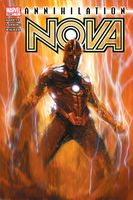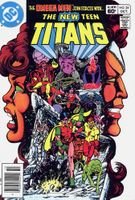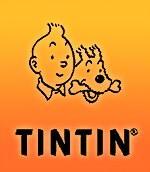Vol. 2, No. 5
- - - - - - - - - - - - - - - - - - - - - - - - - - - - - - - - - - - - - - - - - - - - - - - -
 In this issue:
In this issue:
reviews of The Battle For Blüdhaven #1-4 and Teen Titans #34-36 / notes on One Year Later Hits and Misses, Mike Mitchell’s Zombie Boy, My Top 50 DC Characters, New (Old) Outsiders in 2007?, and Recent Rentals / rants about various and sundry
- - - - - - - - - - - - - - - - - - - - - - - - - - - - - - - - - - - - - - - - - - - - - - - -

reviews
The Battle for Blüdhaven #1-4 (DC Comics)
Justin Gray and Jimmy Palmiotti (Writers) / Dan Jurgens (Penciller) / Jimmy Palmiotti (Inker) / Javi Montes (Colorist) / Pat Brosseau (Letterer)

This
Infinite Crisis spin-off is a blast: a B-movie that feels like it actually matters (even if it doesn’t). Gray and Palmiotti’s twisty, suspenseful “dead” Hawkman storyline knocked me out last year, so I was happy that they were helming one of the Crisis epilogues. They haven’t disappointed. The reveals and teases have been fun, and, more importantly, the parade of semi-disposable D-list characters through Nightwing’s old stomping-ground has been a real treat—especially the Atomic Knights, the Force of July, and now the Nuclear Family(!). Can we expect a resurrected Dr. Helga Jace to show up next? Here’s an idea: since Gray and Palmiotti obviously have a soft spot for kooky Barr/Aparo Outsiders allies and villains, how about getting them to write a new classic Outsiders series. (For more on this brilliant idea, see
below.)

And did I mention?
Battle for Blüdhaven is a scrappy little thing: a conspiracy slugfest with teeth. Baby teeth, perhaps, but teeth all the same! The city of Blüdhaven (this one destroyed by an actual "Axis of Evil") has become an inevitable amalgam of recent American disaster zones and the Firebrand v. Father Time face-off serves as an entertainingly broad (but still not inaccurate) riff on the polarized state of political debate in the US. Dan Jurgens’s workmanlike, virtually proletarian art-style (normally not my favorite) is a perfect choice for this mini’s muscular pulp politicking and eighties-style superhero intrigues. And bonus: he can draw Raven’s cowl properly. Young Titans artists who attempt the absurd feat of showing Raven in flight, take note.
Teen Titans #34-36 (DC Comics)Geoff Johns (Writer) / Tony Daniel (Penciller) / Kevin Conrad & various (Inkers) / Tanya and Richard Horie (Colorist) / Travis Lanham (Letterer)

What does it look like? If it didn’t date me so severely, I’d say
Porky’s. So let’s make it
American Pie instead. It’s One Year Later, and the Teen Titans aren’t just New, they’re hot...and bothered. Not that it isn’t all highly amusing, but I’m old enough to remember a time, back in the stone age, when a tiny one-panel above-the-waist shot of Dick and Kory being awakened from their freshly mussed bed in the middle of the night made comics-code puritans hyperventilate. And here we have Rose Wilson, nude, handcuffed, and raring-to-go on Robin’s mattress…
…and lighting a cigarette off of Kid Devil in a scene that would put the subliminal advertising masterminds of Big Tobacco to shame…
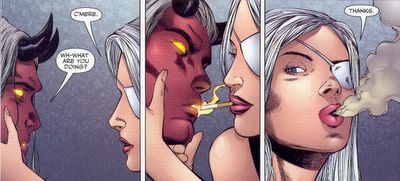
…meanwhile, criminal super-couple Monsieur Mallah and the chrome-plated death-phallus are whispering nothings so sweet and so steeped in double entendres that I can hardly concentrate on the exposition…!

Once one wades through all the teen sex-comedy hijinks, though, one might be surprised to discover that the OYL Teen Titans are notable for something that’s been missing from the title for a long time: chemistry. The two things are obviously related. The title’s recent emphasis on bedroom farce is only the most obvious sign of a new vitality and playfulness that has entered the series in the last few issues. And it’s not all farce either—the developing romance between Rose Wilson and Kid Devil feels both genuine and sweet. In three short issues, Johns has established Rose and Eddie as sympathetic three-dimensional underdogs. Add to the mix a grieving, angry Wonder Girl and a darker, driven Robin. After three years of relative indifference (and many years before that of utter despair), I’ve finally got some Titans I can care about again.
How did this happen?
It’s no secret that the Titans have been in a conceptual muddle ever since the second
New Teen Titans series folded back in the mid-nineties.

Even before that series ended, the stories of many of the characters seemed played out—particularly those characters created specifically by Wolfman and Perez for the relaunch of the original Teen Titans back in the early eighties. After nearly 200 issues, what else could be done with Raven? Starfire? Cyborg? These were Wolfman’s characters all the way, and even though he was burnt out on them, no one else seemed capable of picking up the authorial reigns. The disastrous addition of Danny Chase midway into the second series seemed only to confirm that the Teen Titans had become a team impervious to change or growth. That’s why the spectacular year-long
Titans Hunt storyline was such a relief.
Finally, there was a real acknowledgment that everything had to change—and change radically—in order to reinvigorate the series. Suddenly, instead of the usual faces, Raven’s mother Arella took center-stage with Deathstroke, Wildebeest, Phantasm, Red Star, and yes…even Pantha. Cyborg was rebuilt. Joey was revealed as a traitor. And it was all damn exciting—one of the best Titans stories since the five part Trigon arc that inaugurated the second series. Sadly, the renaissance was short lived. New character additions grew increasingly absurd, the series soon degenerated into nonsense, and was mercifully cancelled.
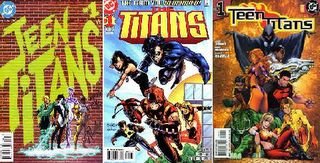
The Dan Jurgens
Teen Titans reboot that ran from 1996-98 demonstrated the difficulty of relaunching the property with new faces. It didn’t help, of course, that despite a tenuous connection to Titans mythology, this was basically a new concept being marketed under a recognizable brand name. I hated everything about it, and so, apparently, did everyone else. The next
Titans relaunch, helmed by Devin Grayson, bent the stick violently back in the other direction, attempting a nostalgic return to roots. But if the sense that the team dynamic had been played out was already palpable in 1996, it was even more powerfully present in 1999 as we were now faced with even older versions of characters like Troia, Cyborg, Starfire, Nightwing, and Tempest, who all improbably regressed, losing all the depth they had achieved during the height of Wolfman’s run. This version of the series occasionally transcended the oppressive weight of nostalgia (thanks to the addition of Roy Harper, Jessie Quick, and others) but on the whole, it confirmed the truism that you can never really go home again. The bewildering arrival of not one, but FIVE Danny Chases (those oppressive DEO kids) to reboot the series mid-run neatly illustrated the degree to which DC editors at that time had learned nothing from the failure of the Dan Jurgens
Teen Titans.
When Geoff Johns set about launching the current
Teen Titans series in 2003, he showed that he had learned the lessons of both previous flops. Like Devin Grayson he combined old and new Titans, but with a greater sense of novelty and change. Indeed, the presence of the older Titans now seems like it was a bait-and-switch strategy to lure back the old readers while foregrounding and promoting the Young Justice Titans into familiar roles. This had many obvious advantages, chief among them was that Johns’s “new” Titans felt reassuringly familiar to old fans like me. I was ready to give Tim, Cassie, Bart, and even Connor a chance just because, when combined with Raven, Cyborg, Starfire, and Beast Boy, Johns’s Titans at least
looked like the (old) New Teen Titans. (Yes, I really am THAT easy.)
But, even with the bone that Geoff tossed to aging fanboys like myself, something about the new series has never felt right. For awhile I thought it might be the pacing (I miss the density of those un-decompressed old stories), or perhaps just the art, which has never done much for me. What the OYL revamp reveals, however, is that it’s the composition of the team itself that’s been holding back the new series.

Johns’s hot-of-the-press
Titans interview at newsarama (which, serendipitously, was released while I was in the middle of writing this) confirms as much: “I wanted to shake the team up, and I was nervous doing it. I knew the reactions would be ‘Ravager?!’ and ‘Who the #@$% is Kid Devil?’ But because of Superboy’s death, it forced us to take chances, and I’m glad. For a long time our line-up seemed to look like the former Young Justice kids smashed together with the New Teen Titans. It was great for the first three years of the book but it was time for something new. And the OYL to me seemed like an opportunity, and a requirement, to seriously alter the status quo.” Hear, hear. It’s easy to see why Johns needed to start this series the way he did, but what we’ve been reading since his
Teen Titans #1 was essentially a drawn-out transition from the often forgettable, sometimes awful Titans stories of the post NTT-era. Even with only three issues in the bank, the OYL
Titans series is already far more interesting than the “smashed together” Young Justice Titans of the past three years.

Clearly, Johns has not abandoned any of his nostalgia for the Wolfman/Perez
New Teen Titans, but now, finally, this nostalgia no longer takes the form of hollow quotation (an all-new Wonder Girl! Kid Flash! Robin!) but rather, quotes and synthesizes more creatively: Kid Devil is a kind of junior Trigon with the wounded horn-dog sensibility of a young Gar Logan, and Rose Wilson is an all-new Ravager explicitly crossbred with the dangerous Lolita edge of the original Terra. (Indeed, their budding romance hits all of those old Gar-Terra buttons all over again, but with a difference.) Rather than trying to literally reproduce the Wolfman/Perez Titans, the new Teen Titans lineup seems to be trying to reproduce the underlying chemistry of those characters that made that beloved incarnation of the team so great. Moreover, like its predecessor, it gestures at the past without being slavishly tied to it. The numerous failed Titans series cluttering up my longboxes ably demonstrate how difficult this formula is to master, but if anyone can do it, it’s Johns. The fact that the forthcoming “membership drive” storyline sounds reminiscent of Titans Hunt is a bonus. (The only dismaying note in all this is the introduction of Wendy and Marvin as “caretakers” of the Tower. Oh brother. Did someone owe Alex Ross a favor? I’m trying to keep an open mind.)

The current storyline, which sees the return not just of a cool and creepy new Doom Patrol, but the reintegration of
Grant Morrison’s Doom Patrol into the DCU is itself cause for celebration. Whereas many of the Titans stories of the past three years have felt more like Young Justice: The Next Generation, for this fan at least, the Doom Patrol story set in the Chief’s haunted castle feels like a
real Titans story—a story that grows organically out of the strongest period of the Titans mythology and promises a satisfying mix of new and old. Johns concludes his newsarama interview by noting, “We’ve been, obviously, taking a big risk with the new direction of
Teen Titans but we really wanted to take advantage of the OYL jump and shake the book up.” All I can say is: it’s about time.
 notesFor the Record: DCU – One Year Later Hits and Misses
notesFor the Record: DCU – One Year Later Hits and Misses
The One Year Later DCU is breaking my bank account, and they’re not done yet—but who needs food and clothing? Not surprisingly,
52 is at the top of my pile every week. The weekly pace and focus on cool second-stringers gives this series a sense of realism and depth that is often difficult to achieve when dealing with iconic characters like Superman, Batman, and Wonder Woman. Joe Bennett’s snazzy pencils deserve extra credit for the feeling of depth that attaches to the 52 DCU: finally, someone’s drawing detailed BACKGROUNDS again. Beautiful work, Joe! Needless to say, I love J. G. Jones’s covers, the detail-oriented storytelling, the weekly cliffhangers, and those little quarter-page teasers. The weekly reponses by comics fandom add to the fun. Mark Fossen’s
52 on 52, Douglas Wolk’s
52 Pick Up, and of course DC’s official
52 Website are all icing on the cake. Finally, Mister Mind’s cocoon??? Oh Grant, you are the master of all things. A thumbnail microcosm of the new DCU.
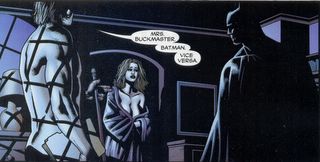
Of the regular OYL titles,
Batman,
Detective Comics,
Superman,
Action Comics, and the
Teen Titans are all better than they’ve been in ages. (Is it just me? Or is "The Crime File of Jason Bard" not hilarious?) I’m also enjoying the slick-looking and smartly-scripted
Firestorm, which I just started picking up. The Best OYL title, however, may actually be one that they’ve tampered with the least. Gail Simone and Paulo Siqueira’s
Birds of Prey remains DC’s powerhouse sleeper—probably the smartest and most consistently entertaining mainstream comic DC publishes.

If you’re not reading it yet, I may have to reevaluate our friendship.
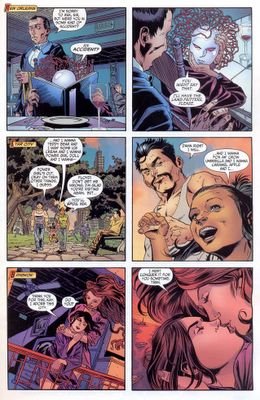
Not surprisingly, Gail’s
Secret Six is the strongest of the Crisis spin-offs – the high-octane weirdness of the Villains United mini continues unabated here. Gail’s crackling, bizarre, surprise-laden script continues to pull no punches and is abetted by Brad Walker and Jimmy Palmiotti’s gritty, sensual art.
As mentioned above, I’m enjoying
Battle for Blüdhaven and am thrilled that Willingham is back as both writer and artist on the
Shadowpact ongoing.
Blue Beetle is worth your time and shows enormous promise. The most pleasant surprise of the post-Crisis spin-offs so far, though, has been
Checkmate. The OMAC Project miniseries was okay, but issue #2 of Rucka and Saiz’s new secret agent book is fantastic. Rucka’s novelistic script feels like a return to the heyday of Ostrander’s Suicide Squad and Saiz’s art really classes up the joint. Just look at his rendering of Kobra, stunningly realized as a slithering blend of old
Eerie Magazine snake pits and Perez’s Brother Blood. I have very high hopes for this title, which is poised to be DC's most “adult” book, and I hope the team of Rucka and Saiz sticks together for the long haul.

This isn’t to say that there haven’t been a few question marks or even fumbles. I’m keeping my fingers crossed for
Aquaman: Sword of Atlantis. Guice’s art is exquisite, I’m enjoying the mystery that Busiek’s spinning, and digging the weird characters and exotic locales. But there’s a lot of exposition here, and there’s also something a bit hokey about the series’s undersea primitivism (eg. King Shark’s grass skirt). I want to love this, but like most good fantasy epics, this one’s probably not going to fire on all cylinders until the groundwork has been laid. I’m willing to be patient because the book is so beautiful, but with so many good titles vying for attention, I’m worried that this one may not have the luxury of a slow start. Another strange one is
JSA. While I’m sure the relaunch of
The Justice Society of America will be great, the Levitz/Rags/Ross/Perez story is turning out to be sort of underwhelming. With a creative roster like this I should be riveted, but I’m just kind of…mildly entertained. And then there’s Winick’s
Outsiders. Before Crisis, this was the book I loved to hate—and sometimes just hated. The recent Jay Garrick reveal was nifty, but this series is a drag.
Tom Bondurant has already summed up my thoughts about
Hawkgirl, which has certainly been the biggest disappointment of the batch. Like everyone else, “I really wanted to like this” but Simonson’s gothic pulp adventure feels like too radical a U-turn for this series and—legend or not—Chaykin is not the right artist for Kendra’s adventures. The line work is stiff and the inking is so clotted in places that the visuals just feel murky rather than atmospheric. Despite the tepid Rann-Thanagar issues, this series was just hitting its stride under Gray and Palmiotti’s tenure. Perhaps a further reshuffling of creative teams is in order, but I’m sticking with it for now.
Mike Mitchell’s Zombie Boy

I’ve been corresponding recently with Mike Mitchell, whose nifty new self-published comic book, Zombie Boy, is now available for order over on his new blog,
Mitchell Family Comics. (Here’s a
link directly to a promo post on Zombie Boy.) Mike’s art-style harkens back to the wonderfully creepy EC horror titles of the 1950s—Tales From the Crypt, The Vault of Horror, and The Crypt of Terror—but his tale of an undead teenager’s search for justice and meaning transforms the motifs of classic horror comics into a very personal-feeling existential questioning of life, morality, and authority. I really enjoyed Mike’s first 16-page effort, Zombie Boy #1, and eagerly await the second issue, which is apparently well underway. Be sure to check out Mike’s site and to give Zombie Boy a try!
My Top 50 DC Characters (The Great Curve)Well,
that was fun. Thanks
Tom! At this point, no one’s interested in who guessed right, only in the freakshow of embarrassing disclosure. I therefore present my omissions and overlaps without comment, and try vainly to justify some strange choices. (Oddities are linked to their wikipedia entries.) As I look at this list now, many of the choices and rankings are objectively indefensible. How did Wonder Woman end up at #29, trumped by Metamorpho and Vandal Savage? Sorry Diana. Clearly, I shouldn’t be allowed to fill out surveys.
Glaring Omissions: Doctor Fate (50), Animal Man (47), Green Lantern/Alan Scott (46),
Black Adam (45), Sandman/Dream (44), The Atom (43), Bizarro (42), Jonah Hex (40), Elongated Man (39), John Constantine (38), Booster Gold (35),
Guy Gardner (33), James Gordon (32), Mister Miracle (31), Alfred Pennyworth (30), Impulse/Kid Flash (28),
Power Girl (27), Flash/Barry Allen (25), Plastic Man (24), Blue Beetle (22),
Two-Face (21), Robin/Tim Drake (19), Space Cabby (18) [???], Aquaman (17), Catwoman (16),
Starman (13), Martian Manhunter (12), Green Arrow (10).
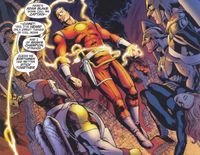
My Picks:1. Swamp Thing (37)
2. Batman, Bruce Wayne (1)
3. Superman, Clark Kent (2)
4. Lois Lane (11)
5. Joker (3)
6. Robin/Nightwing, Dick Grayson (4)
7. Oracle, Barbara Gordon (7)
8. Green Lantern, Hal Jordan (14)
9. The Question, Vic Sage (26)
10. Darkseid (23)
11. Spectre, Jim Corrigan (34)
12.
Starro –
Such a brilliant, simple design. The horror of the swarm and its vicissitudes.13.
Solaris –
Genuinely frightening. The secret location of Grant Morrison’s brain.14. Captain Marvel, Billy Batson (9)
15.
Vandal Savage –
DC’s great Bond-villain.
16. Lex Luthor (5)
17. Phantom Stranger (48)
18.
Metamorpho, Rex Mason –
Visually, one of DC’s most striking classic characters. A poor man’s Ben Grimm, perhaps, but Mike W. Barr and Jim Aparo made me love him in BATO.
19. Adam Strange (41)
20. Hawkman, Carter Hall (36)
21. Deathstroke, Slade Wilson (52)
22. Zatanna (20)
23.
Black Lightening, Jefferson Pierce –
Another Outsider. Anyone seeing a pattern here?24. Cyborg, Vic Stone (51)
25.
Speedy/Arsenal, Roy Harper –
Before anyone was exploring the idea of the fallen side-kick, there was Speedy. One of those rare characters who seems impervious to writerly bungling and, in the right hands, potentially DC’s most interesting fuck-up.26. Flash, Wally West (8)
27. Black Canary, Dinah Lance (15)
28. Mister Terrific, Michael Holt (49)
29. Wonder Woman, Diana (6)
30.
Crazy Jane, Kay Challis –
The archetypal Grant Morrison character and a curious but not inappropriate legacy for one of William Butler Yeats’s most interesting poetic masks.31.
Robotman, Cliff Steele –
Am I really the only one who thinks he belongs on this list??32. Flash, Jay Garrick (29)
33.
Wildcat, Ted Grant –
JSA #10. Read it NOW.34.
Raven –
Visually, the best Perez-designed New Teen Titan. For some reason, no one else seems capable of drawing her. For that matter, since Wolfman, no one seems capable of writing her either. Thrilled that he’s writing the new mini.35.
Wonder Girl, Donna Troy –
Despite the recent attempt at resuscitation by Jimenez, Garcia-Lopez, and Perez, still DC’s most ruined character. Some of us still remember, though…and carry a torch.36.
Starfire, Koriand’r –
Perez’s alien dream-girl is much mocked, but unfairly. On par with Raven as a superb character design. For better or worse: iconic. 37.
Katana, Tatsu Yamashiro –
Judd Winick is currently showing us why this complex female samurai makes no sense without Halo. Hopefully a reunion is in the works.38.
Amanda Waller –
A stereotype grown complex. As important to DC as Nick Fury is to Marvel.39.
Captain Cold, Leonard Snart –
Blame Geoff Johns for this one. His Flash stories sold me.40.
Shade, the Changing Man –
Steve Ditko’s design is stunning and the Vertigo series was a favorite. I wish they’d bring him back.41.
Amethyst, Amy Winston –
Bear with me. I’ll explain in more detail this summer.42.
Brother Blood –
Trigon was great, and probably belongs on this list too, but Brother Blood scared the crap out of me. Another perfect Perez design, though I hate what Johns did with him in the new series.43.
Blue Devil, Daniel Patrick Cassidy –
I must have a thing for Dan Mishkin characters. I loved this comic! And Blue Devil’s look epitomizes (with Booster Gold) a period of fun eighties creativity that has been much underrated, though is happily making a splashy comeback in the current DCU.44, 45, 46.
Projectra/Sensor Girl,
Wildfire, Drake Burroughs,
Karate Kid, Val Armorr –
Very personal choices that I will explore in more detail at some point. It’s difficult to pick a favorite Legionnaire, but Jeckie, Wildfire, and Val were three of my early obsessions, likely because, as a young reader, they each embodied fairly archetypal (and now somewhat embarrassing) ideals and fantasies.47.
Baron Winter –
I’ve said it before. I’ll say it again: DC needs to collect Marv Wolfman and Gene Colan’s paranormal masterpiece, Night Force.
48.
Captain Comet –
I have a thing for Captain Comet. I can’t explain it. Needless to say, the announcement in this post at newsarama made me very happy.49.
Doctor Phosphorous –
The coolest-looking second-string Bat-villain ever. Please Grant, revive him.50.
I…Vampire, Andrew Bennett –
Before Anne Rice’s Lestat and friends, there was I…Vampire. Admit it, if you’d thought of it, he’d have been on your list too.New (Old) Outsiders Series in 2007?I know, I know.
You’re sick of hearing about it. And there’s nothing more pathetic than a grown man’s nostalgia for childhood fantasy-objects. But the signs are there. They really are.
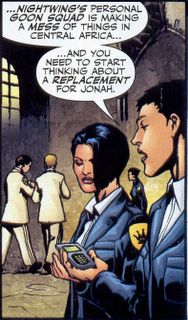
Battle for Blüdhaven currently showcases the return of off-beat Outsiders-villains, the pathologically patriotic Force of July and the Nuclear Family—Mike W. Barr and Jim Aparo’s ingeniously imagined satire of the “perfect” 1950s nuclear-family that turns the fears of the Atomic Age into a clever metaphor for normative dysfunction from
Outsiders (second series) #1-2.
You can’t turn around without bumping into Black Lightening and Metamorpho these days. And Katana is back in full force too, currently awaiting rescue from “Nightwing’s personal goon squad,” as Greg Rucka so aptly calls Winick’s cheerless
Outsiders OYL reboot.
And…what have we here? Gail Simone and Dale Eaglesham’s exquisite
Villains United Special had more than a couple of classic Outsider cameos:

I also note the interesting
announcement of a reprinting of the Terra stories from Wolfman and Perez’s
New Teen Titans 26-34 in trade paperback…in advance of the reprinting of these issues in the slowly emerging archive editions of the series. Where Terra goes, can Geo-Force be far behind?
And what about this late addition? (I wrote this last week, before
52 #4 came out.) There’s Halo doing her “Auracle”-speak right there on pages 1-3. I tell you, the writing is on the wall!
DC wouldn’t toy with me would they? And even if they would, surely Gail Simone isn’t so cruel! Right Gail? Um…Gail?
My new Classic Outsiders creative dream-teams: Gail Simone & Dale Eaglesham OR Justin Grey, Jimmy Palmiotti, & Joe Bennett. I'm not choosy, really. Either would be fine!
The Screening Room: Recently ViewedWhy have I been renting so many movies lately? Perhaps to make up for the pain of my recent trips to the multiplex. So, thanks
Da Vinci Code!
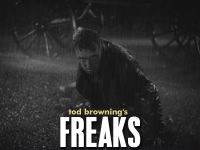
Tod Browning’s
Freaks (1932) – Carnivalesque exploitation (literally) with a guilty conscience. Moody and weird; the climax—though brief—is unforgettable.
All About Eve (1950) – Joeseph L. Mankiewicz’s ultimate showbiz satire is wicked, cutting, brilliant – pick your adjective. They sure don’t make them like they used to. Plus: all the corrosive, dead-pan wit you’d expect from Bette Davis.


Rebecca (1940) – Hitchcock’s creepy and exquisitely filmed gothic romance. The Mandelay scenes are transporting and the suspense about the
first Mrs. DeWinter is torturous. The spectacular first hour and denouement, more than make up for the draggy third quarter.
Don Siegel’s
Escape from Alcatraz (1979) – Compelling, uncanny, and possibly profound. The beauty of this film is its gritty simplicity, but there’s more to its relentlessly linear narrative than meets the eye. Clint Eastwood is fantastic in the lead role. My favorite closing credits sequence ever. (Like the film itself, they are an eerie masterpiece of understatement and suggestion.)
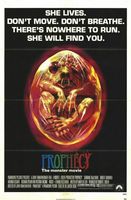

Prophecy (1979) – Tedious eco-terror, occasionally relieved by so-bad-you-laugh monster effects. Amusing bonus for Falcon Crest fans: Robert Foxworth stars.
Appointment With Death (1988) – A somewhat inept adaptation of the Agatha Christie novel with Peter Ustinov as Poirot and all the usual suspects. Cheesy fun, primarily for the broad, shtick-heavy performances by Piper Laurie and Lauren Bacall. Carrie Fisher is fun to watch, as always, even though her part makes no sense.

David Lynch’s
Lost Highway (1997) and
Mulholland Dr (2001) – a great pair to view together, given the prominence of the road-motif in both. The latter is a psychoanalytic masterpiece, set aglow by Naomi Watts’s luminous performance (has real/fake joy EVER been so convincingly portrayed on screen?); the former is grungier, more disorienting, and completely unsettling. Robert Blake, in a hair-raising role, stays with you. And not in a good way. (On Mulholland Dr, see David Fiore’s fascinating
round-up). High on these arresting nightmare visions, I let my guard down and rented Lynch’s dismal sci-fi snooze-fest,
Dune (1984). This was my second try and I think I made it more than half way this time. GodDAMN that is a boring endurance-test of a film.
Just watched the fascinating
Donnie Darko (2001) for the first time a couple of nights ago. Still pondering. And still humming that damn INXS song.
And while I’m on the topic of movies, let me plug
my debate with
Thomas over
X3 one last time. If you’ve already suffered through it (and even if you haven’t) click on over to David Golding’s wonderful
Pah! for another enthusiastic and intelligent take on
X3. Like Thomas, David liked it more than I did; between the two of them, my resolve is beginning to crumble…a LITTLE. (Update: David has just added a second response
here.)
Finally, even though it’s old news now,
V for Vendetta is still my favorite superhero film of the year. Marc Singer, sharp as ever, explains why (with several caveats) in his superb
review essay on the film.
 rantsVarious and Sundry
rantsVarious and SundryThe LAST issue of the
The Thing came out last week. Even though we lost perfect Thing-penciler Andrea DiVito a couple of issues back, this one still rankles. Way to stand behind great books, Marvel. Wow…seven WHOLE issues.
I love Blogger. Honest. And I’m reluctant to bash them for any reason, given that they have so kindly given me this wonderful little space on the web FOR FREE. But Blogger’s Image-upload function has been ignoring my desperate, tearful petitions for several days now, despite much cache-clearing and rebooting activity on my part. I’ve resorted to uploading through Hello and reformatting the pics manually – quite a trick, given my rudimentary (one might even say “stone-age”) knowledge of html. As always, dear readers, your technical advice is welcome!
















